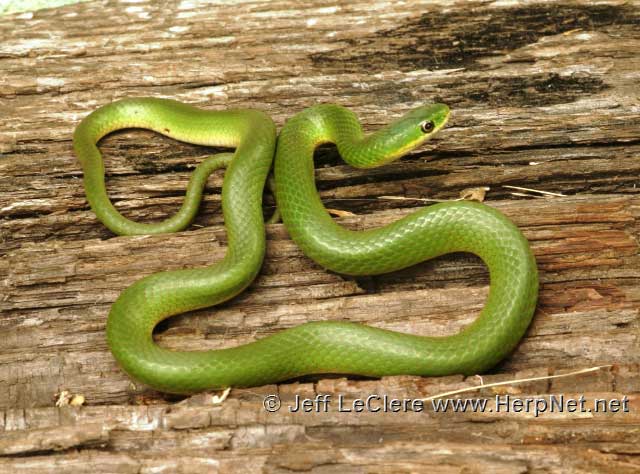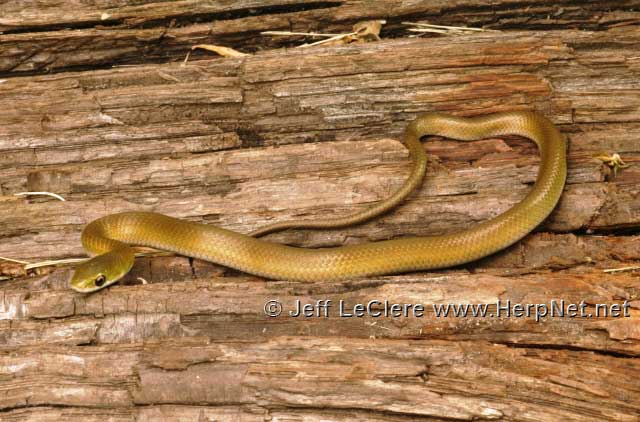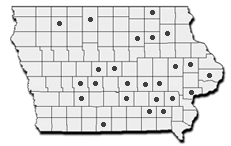Smooth Green Snake (Opheodrys vernalis)
Alternate names: Smooth Greensnake
by Jeff LeClere



Status
SPECIAL CONCERN and Species of Greatest Conservation Need. It is illegal to kill or collect this species by law in Iowa. These sensitive little snakes are always worth reporting when found. Please report sightings in Iowa to us or the DNR. Some formerly listed the genus as Liochlorophis.
Description
Harmless to humans. This snake is not likely to be confused with any other snake in Iowa. It is 12 – 22 inches in length. It has no outstanding markings, but it is a bright, brilliant green. The belly is usually bright yellow, but sometimes may be cream instead. The labials are the color of the belly. Some specimens may be buff or tan above instead of green. These variants have been reported from central Iowa. The scales are smooth (hence the name) and the anal plate is divided.
Subspecies
No subspecies of smooth green snake, Opheodrys vernalis, are recognized any longer.
Range
The smooth green snake is found in scattered populations in Iowa. Its range once supposedly spanned across most of Iowa and much of north central and northeastern North America. Now, it is greatly reduced to various populations scattered throughout its natural range. This snake not only suffers the restrictions of many other species of snakes, but it is extremely limited by the use of pesticides due to its insectivorous diet (Oldfield and Moriarty 1994; Smith 1961). Johnson (1992) states, “special measures will be needed to ensure their survival, including protecting and improving the habitat, eliminating pesticide use.” Missouri has now listed this snake as extirpated (Levell, 1997). I am aware of a few small populations of smooth green snakes that have become extinct in eastern Iowa in recent years due to habitat destruction. Christiansen (1991) stated that there are fewer than ten populations left in Iowa. The loss of any populations are extremely detrimental. The public has been outstanding reporting this snake when found.


Habitat
The smooth green snake is found in a variety of habitats such as grassy, moist meadows, native prairies, and clearings in coniferous pine forests. This snake is seen crossing bike or hiking trails, or brought home by cats or dogs that hunt in large open fields, particularly near railroad tracks.
Habits
This snake is largely diurnal and less secretive than our other small snakes. It spends most of its day forging through tall grass or small shrubs, and though it is an accomplished climber, it is mostly terrestrial. It does not spend as much time under cover as other Iowa snakes, but do not underestimate the effectiveness of searching under boards, flat rocks, or other objects for these snakes.
When approached in the field, these snakes take off for a short distance then freeze or gently sway with the grass, perfectly camouflaged. Most are discovered only when they venture onto the road. When they are picked up, they may thrash for a bit, but they rarely bite. I have witnessed an interesting behavior in one specimen. It twisted about and opened its mouth and feigned death. When it was left alone, it tried to crawl away normally. Once disturbed again, it resumed the act.
Persons finding a dead small, blue snake may mistake it for a racer. If it was a racer the size of an adult green snake, it should have a spotted juvenile pattern. After death, green snakes turn blue in dorsal coloration. Yellow and blue pigments in the skin fuse to produce the bright green color in the living snakes. After death, the yellow pigment breaks down very quickly, whereas the blue pigment is more stable and remains much longer. This is also why garter snakes, that have been dead for a while have blue dorsal and lateral stripes.
Green snakes overwinter in burrows, rock crevices, road embankments, and (at least in northern Minnesota), ant mounds (Lang, 1969). Large numbers of green snakes have been found together with redbelly and plains garter snakes overwintering in these mounds.
Breeding occurs in spring. They are oviparous laying 3 – 15 eggs in a clutch. Several females may nest together. Incubation and laying varies greatly among individuals. Some female green snakes may not lay the eggs until a week or even days before they hatch. Some have retained the eggs until they hatch inside the female like ovoviviparous snakes. A friend of mine and I have found green snake eggs under a railroad tie in western Wisconsin. They had grown to the size of milk snake eggs! They hatched in about a month. The young were 4 – 5 inches long and noticeably darker green than the adults.
Food
Smooth green snakes are one of the few species of snake that is entirely insectivorous. They like crickets, grasshoppers, spiders, and smooth caterpillars. This is probably one of the reasons this snake has declined in abundance. Along with habitat destruction, pesticides have undoubtedly reduced these snakes to the isolated populations in which they now exist. If anyone finds a smooth green snake in Iowa, contact us or the DNR.